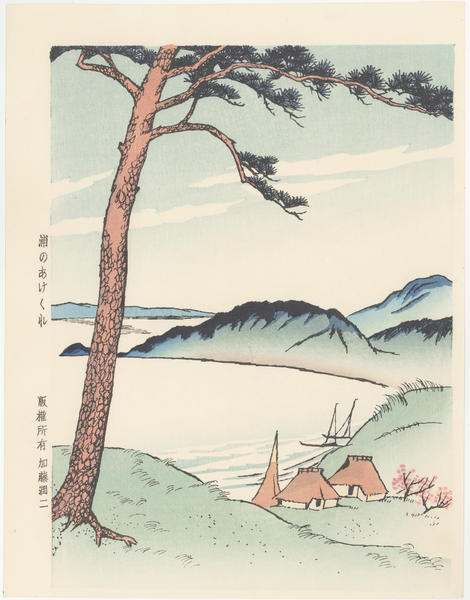| | |
| Artist: | Takehisa Yumeji (1884-1934) — 竹久夢二 |
| Title: | Day In, Day Out, at a Bay — 浦のあけくれ |
| Series: | Yumeji Masterpieces — 夢二名作集 |
| Date of first edition?: | 1938-1939 |
| Publisher (first edition)?: | Kato Junji |
| Publisher (this edition)?: | Kato Junji |
| Medium (first edition): | Woodblock |
| Medium (this edition): | Woodblock |
| Format (first edition): | Aiban
|
| Format (this edition): | Aiban |
| DB artwork code: | 48047 |
| Notes (first edition)?: |
|
| Notes (this edition)?: |
| The following information was taken from the original web listing of this artwork. Note that there may be some inaccuracies:
Thanks to The Lavenberg Collection of Japanese Prints for this entry.
Japanese Color Woodblock Print
Ura no Akekure (Day In, Day Out, at a Bay)
from the series Yumeji’s Materpieces
by Takehisa Yumeji, 1938-1939
(after an earlier 1926 design)
About This Print
One of a number of posthumous prints created from Yumeji's illustrations by the Tokyo-based publisher Katō Junji. This design was originally made for the below 1926 cover of the musical score forJoseph Mazzhing's Ye Shephers Tell Me (The Wreath. A Pastoral Glee for Three Voices), published by Senow Ongaku Shuppansha.
Of the two impressions, IHL Cat. #1621 is printed on a heavier paper and appears to be an earlier printing than #1575.
Source: Takehisa Yumeji, Nozomi Naoi, et. al., Brill, 2015, p. 14.
"The prints in Yumeji masterpieces highlight Yumeji's skillful treatment of the landscape genre. Tranquil, bucolic scenes such as this illustrating a hamlet nestled along a bay were a frequent them in Yumeji's art, and it could be conjectured that it conveyed a sense of nostalgia for his native Okayama or the port city of Kobe where he briefly spent time during his childhood."
Print Details
Title: Day In, Day Out, at a Bay [alternate translation: Timeless Bay]
Ura no Akekure 浦のあけくれ - as written in the top of the left margin
Series: Yumeji’s Masterpieces
夢二名作集 Yumeji meisakushū
Artist: Takehisa Yumeji (1884-1934)
Signature: not signed
Seal: not sealed
Publication Date: originally 1938-1939
Edition: unknown - prints from the series were reprinted an unknown number of times during the life of the publisher
Publisher: Katō Junji 加藤潤二 [Katō Hanga Kenkyūjo]
copyright owned by Hanken shoyū Katō Junji 版権i所有 加藤潤二 - as printed in left margin
Genre: fukusei hanga
Format: ōban
H x W Paper
#1575: 13 x 10 in. (33 x 25.4 cm)
#1621: 13 x 10 1/16 in. (33 x 25.6)
H x W Image
#1575: 11 15/16 x 8 3/4 in. (30.3 x 22.2 cm)
#1621: 11 15/16 x 8 3/4 in. (30.3 x 22.2 cm)
Reference Literature
Takehisa Yumeji, Nozomi Naoi, et. al., Brill, 2015, fig. 1.5, p. 14. |
|
| Series Information: |
| The majority of Yumeji's woodblock-printed designs were released after his death in 1934. The publisher who was instrumental in having Yumeji's work recognized was the Tokyo-based Katō Junji (1885-1961). During the late 1930s and early 1940s. Katō and his team of artisan block-cutters and printers at the Katō Print Workshop (Katō Print Workshop) (Katō Hanga Kenkyūjo) reused and recalled numerous famous paintings, music scores and watercolours for series of prints and postcards. The thirty woodblock prints in this set are a selection of the most popular cover designs from the over 270 that the artist produced of Seno music scores. Katō Junji personally compiled the set and it reflects what he believed was representative of Yumeji's artistic diversity, ranging from the portrayal of beautiful women and landscapes to this fascination with Western artistic styles. (from The Lavenberg Collection of Japanese Prints). |
|
| Artist Bio: |
Takehisa Yumeji (1884-1934) was a leading figure in the Taisho Romanticism movement that combined Western romanticism with native Japanese styles during the Taisho Period (1912-1926). He was a painter, writer, poet, bookbinder and illustrator whose drawings of women with thin bodies and large eyes filled with melancholy were known as Yumeji Bijin-ga. During the height of his popularity he was called the “modern Utamaro” and the Japanese “Toulouse-Lautrec and Edvard Munch”. His prints epitomized the relationship between popular art and the woodblock.
|
|


